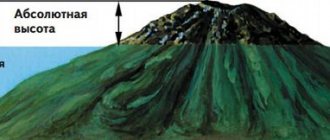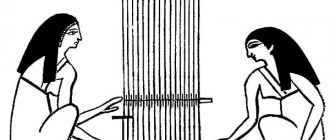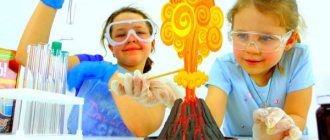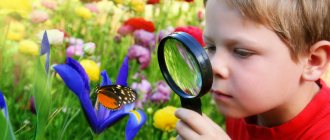All that is needed
For the experiment you will need some household chemicals and decorative elements to create an island. The volcano island can be made from natural materials or use dinosaur sensory box sets.
A model of a volcano is made from plasticine. Creating a fabulous volcanic island for the experience is the main component of it and serves to develop the child's imagination and creativity. Such activities will help instill a love for chemistry and geography. The child will develop fine motor skills of the fingers while making plasticine terrain and its inhabitants.
To make an island you need:
- cardboard;
- stapler or narrow tape;
- box with colored plasticine;
- small animal toys;
- colorful pebbles;
- a large plastic box or bowl in which the island will stand;
- glass or plastic container with a volume of 200 ml for the volcano crater.
To conduct the experiment you will need:
- soda 20 g;
- food coloring:
- vinegar 9%;
- dish detergent 25 ml;
- water 100 ml.
Usually the experiment continues until mom runs out of all the baking soda and vinegar, so be patient.
Children cannot carry out the experiment on their own without adults. If vinegar gets into a child's eyes or mouth, it can cause a burn to the mucous membranes, and if swallowed, it can cause a burn to the esophagus.
Making a fairytale island
You can build an island in a large plastic container. Pour real water and line the bottom with round pebbles. Make a container for the volcano from a baby food jar or an old glass. For the mountain inside which the container will stand, you need to make a cardboard model; your child will be happy to cover it with plasticine.
The sequence of making a volcanic mountain:
- cut out a circle of the required diameter from thick cardboard;
- make a cut from the edge to the center of the circle;
- roll up a cone;
- the edges of the cone are fastened with a stapler or tape;
- cut off the upper part of the cone at a height equal to the container chosen for the volcano;
- place the container inside the cone.
I coat the top of the mountain with plasticine. To do this, roll out small brown plasticine cakes and stick them to a paper cone, completely covering the cardboard. The top of the volcano can be made of red plasticine, which will imitate hot lava.
They place a volcanic mountain on a dry island of pebbles. They are seated around small rubber animals that are among children's toys. Multi-colored amazing dinosaurs or wolves, foxes, bunnies, bears and other inhabitants of the forest and jungle. Depending on what animals were planted, vegetation for the island is selected. Large tree ferns and horsetails for dinosaurs, and ordinary fir trees and birches for bunnies and foxes.
Plastic plants are also often sold in sets for children's games. You can use a leaf of a living fern and twigs of plants if it is summer outside.
Plants can also be molded from plasticine, made from threads and beads or ordinary cardboard.
You can make small houses out of cardboard for plastic Indians and soldiers. It is better to use cardboard to make plants and houses when the island is in a container with blue-dyed sand instead of water or on a blue plasticine sea.
Progress of the game
Znayka comes to visit the children. He talks with the guys about the content of the fairy tale “The Three Little Pigs”
;
finds out what materials people use to build houses: “What is good about a wooden house? (It is beautiful, warm, bright, cozy, easy to breathe in.)
What could harm this house?
(Fire, dampness)
What can you say about a brick house?
(Brick is durable, strong; building material can be white or red) What other material can you build a house from? (Made of concrete)
."
The teacher suggests approaching the concrete wall of the kindergarten and determining what it is like. The children find out that the wall is smooth, solid, and durable. The teacher suggests: “Now you and I will try to make concrete ourselves. For this we have sand, water, crushed stone, cement.”
The teacher and children mix all the ingredients and pour them into different molds; the teacher explains that these molds are called formwork: “In order for the concrete to become strong, it is poured into the formwork and left to harden. From time to time the surface is moistened with water. A small amount of concrete can be made by one person. If a lot of concrete is required, it is made at a concrete plant.” Children look at photographs showing a concrete plant, its workshops, concrete mixers that mix the necessary components of a container for pouring concrete, and cranes that lift finished slabs.
Experiment “How to inflate a balloon?”
Materials:
1) soda
2) vinegar
3) plastic bottle
4) balloon
Conducting an experiment
Finally the island is ready. All the toy animals and people froze in anticipation of an interesting event - a volcanic eruption. They know that the volcano is not real and therefore are not afraid of it.
To conduct the experiment, pour a tablespoon of soda into the volcano jar. Add a tablespoon of dishwashing detergent. Red or orange food coloring is dissolved in 100 milligrams of water and added to the baking soda and detergent. The base for the experiment is ready, all that remains is to add vinegar. For mom, you can let your child pour vinegar into the volcano on his own, under her supervision, so that he doesn’t do it in her absence. It is better to repeat the experiment for an encore, pouring vinegar into the “mouth” of the volcano and pouring soda into it until the child is interested in it and asks to repeat the experiment.
When vinegar is added, the baking soda will begin to foam, erupting from the “volcano mouth” like red or orange lava. The detergent will allow the “lava” to foam longer and more abundantly, overflowing from the vent and flooding the surrounding area along with plants and animals that were carelessly located too close.
Form of organization: (group, subgroup, individual, pair). Educational and methodological set: Program “From birth to school” edited by N.E. Veraksa Goal: development of cognitive interests. Objectives: Cognition: - enrich the consciousness of children with new content that contributes to the accumulation of ideas about the world around them; - expand children’s understanding of objects and phenomena of inanimate nature; expand ideas about a natural phenomenon - a volcano. -develop activity, initiative and independence in the process of performing experiments.. Communication: -expand vocabulary based on the various ideas about the world that children develop, activate them in independent statements; - activate vocabulary in speech practice: lava, volcano, volcanologists, ash, dormant volcano, active volcano, extinct volcano, etc. Socialization: - cultivate interest and desire for creative knowledge of the world around us; - create a condition within the lesson for children’s independent cognitive activity. - support the child’s desire to actively interact with peers and adults; -to form equal, friendly relationships between peers; Health: - strengthen the health of children; -to develop experience in following safety rules when conducting physical experiments. Problem question: What is a volcano? Hypotheses: 1. A volcano is a fire-breathing mountain. 2. A volcano is an ordinary mountain. Equipment and materials: Screen, projector, laptop, computer presentation, pumice pieces, regular stones, bowls of water, balloons, mixture (baking soda, red gouache, dishwashing liquid), vinegar, parcel box, volcano models, material for drawings, drawings, tape recorder with audio recording of music. Preliminary work: -Reading the children's encyclopedia “Everything about everything” comp. O.I.Perfilyev. — Examination of illustrations depicting volcanoes. — Conversations about types of volcanoes. — Making a model of a volcano. The course of joint activities between an adult and children: 1. Relieving psycho-emotional stress. Guys, please come to me. Today many good and kind guests came to your kindergarten. Let's greet them and give them our sunny smiles. And now, we close our eyes and imagine, here and now we imagine ourselves. We forget what happened yesterday, We don’t know what will happen next. We only think about what is now. Good, beautiful, each of you, you are the best thing in the world. Open your eyes, hello children! 2. Motivation for activity. Guys, today the postman brought a parcel from children and teachers from the Skazka kindergarten. Let's open the package and see what's in it. (the parcel contains pumice and drawings) Guys, do you know what this is? The teacher gives the opportunity to look and touch the object. (Children’s answers) Listen to what the guys write: “Dear children! To guess why these items are in the parcel, you need to get acquainted with an amazing natural phenomenon. We have already met him. And with what phenomenon, listen and guess the riddle. He is huge, he is powerful, He is higher than the clouds. He can laugh with a bass voice, and spit fiery porridge. Good old giant - This is grandpa... (volcano) Yes, today our meeting is dedicated to such a mysterious, mysterious, amazing and formidable natural phenomenon as a “volcanic eruption”. 3. Organization of productive activities. Sit on the chairs in front of the monitor. (Showing a presentation about volcanoes “Fire-Breathing Mountains”) In some places on earth there are unusual mountains. (Slide No. 1, 2) When they “sleep” they differ little from other mountains. But as soon as they wake up, flames and hot stones burst out of their peaks (the volcano’s mouth). Volcanoes are shrouded in smoke, explosions sound, hot liquid flows down the slopes - lava, a real fiery stream. Volcanoes erupt. The volcano wanted to sneeze - the pressure rose. The lava was on its way through the vent and set out on an adventure. It swept up the vent, broke through, and spilled out of the holes with a noise and a crash! Oh God! Guys, you know, volcanoes are active, dormant and extinct. (Slide No. 3) Active volcano - when a volcanic eruption occurs. (Slide No. 4) During an eruption, the volcano looks like a raging beast. He growls and bites, and can cause a lot of trouble. Which volcano do you think is called dormant? (Children's answers) Sleeping is a volcano that looks like an ordinary mountain, but can explode with fiery lava at any moment. (Slide No. 5) The volcano sleeps, only occasionally smokes, exhales light smoke into the sky, as if someone is lighting a stove. And a volcano is really an oven, only underground. There is a fire raging inside her all the time. Dormant volcanoes are gathering strength to awaken. Which volcanoes are called extinct? (Children's answers) These are the volcanoes that worked in the distant, distant past. (Slide No. Guys, do you know why fire-breathing mountains are called “volcanoes”? (Children’s answers) Physical education minute. Warm-up begins. We stood up, straightened our backs. Bent to the right and left. And repeated again. (Bends to the sides.) We squat counting, One, two, three, four, five. This is the necessary work - Train the leg muscles. (Squats.) And now we perform arm jerks with you. (Arm jerks in front of the chest). Listen to an interesting legend (calm music sounds). " There lived in Ancient Rome a god named Vulcan and he liked blacksmithing - standing at an anvil, hitting iron with a heavy hammer, fanning the fire in the forge. He built himself a blacksmith inside a tall mountain. When Vulcan worked with a hammer, the mountain trembled from top to base, and the roar and roar spread far around. From the hole in the mountain, hot stones, fire and ashes flew with a deafening roar. “The volcano is working!” - people said with fear and went to live away from this place." Now, guys, we know that the volcano is so named after God, who liked blacksmithing. Did you like the legend? Was it interesting? What does the legend say? Fine! Well done! Look at the shape of the volcano, what does it look like? Children: Looks like a pyramid, a cone. Educator: That's right, guys, the volcano is cone-shaped. Pay attention to its upper part, what does it look like? Children: To a large hole, a funnel. Educator: That's right. Who knows what this part of the volcano is called? Educator: The top of the mountain from which a volcano erupts is called a volcanic crater. The crater of the volcano is a huge bowl with steep slopes, and at the bottom there is a reddish-orange mouth - this is a vent, a hole that goes deep into the ground. The fiery liquid coming out of a volcano is called lava. And now you can watch the volcano erupt. Presentation of video material with sound “Volcanic eruption” Higher than the clouds, Volcanoes rise, Majestic and mighty, Like giants in a fairy tale. 4. Independent activity. Guys, I suggest using experience to find out why a volcano erupts in the first place. Let's go to the young researcher's corner. (Children go to the tables for experiments) Experiment 1. Guys, do you remember about the parcel. What was there? (Answers) Guys, I’ll tell you an amazing fact now. When lava comes out of a volcano, it cools and hardens when exposed to air. Pieces of solidified lava are the pumice that was in our package. Let's look at stones of volcanic origin - pumice and ordinary stones. Look carefully at the stones and pumice. What is the difference? (Answers) There are many holes in the pumice stone. Are the holes empty or is there something in them? (Answers) Air is hidden in the holes, which is why pumice is lighter than ordinary stone. How can this be checked? (Children's answers) I suggest putting pumice and ordinary stones into the water. (Do the experiment) What discovery did we make? (Children's answers) Pumice is a stone in which there are many holes in which air accumulates. Pumice does not sink. There are indeed air bubbles inside the pumice. This is because the lava boiled and seethed, and then froze. Finger game “Spider” (Hands are crossed. The fingers of each hand “run” along the forearm, and then along the shoulder of the other hand.) The spider walked along the branch, and the children followed him. (The hands are freely lowered, we perform a shaking movement - rain.) Rain suddenly poured from the sky, (Clapping of palms on the table/knees.) The spiders were washed to the ground. (The sides of our palms are pressed to each other, our fingers are spread out, we shake our hands - the sun is shining.) The sun began to warm up, (We make the same movements as at the very beginning.) The spider crawls again, (“Spiders” crawl on the head.) And All the children crawl after him to take a walk on the branch. Experience 2. Guys, now I suggest you turn into wizards and try to awaken a volcano. Do you think we can do it? (Answers) (Approach the model of the volcano) Our volcano is sleeping for now, but we will wake it up. The game of volcano lords has begun! We pour a mixture inside the “volcano” (the teacher performs the experiment himself, the children follow the teacher’s actions): baking soda mixed with red gouache and dishwashing liquid. And then... Carefully pour the vinegar slightly diluted with water (only adults can do this) into the “volcano”. And our volcano woke up! Volcanoes began to “volcano” - spew lava from their craters. Lava flowed down the slopes and severely burned the Earth. Centuries later, the evil Vulcan coughed up both ash and ash. The volcano is thundering! The volcano is chugging! How menacing he looks now! But then he began to get tired - the Fire in him began to fade. He breathed fire for the last time - And fell asleep for decades. Centuries will pass... And again the volcano will wake up, And lava will flow from its interior. And our volcano can wake up and fall asleep whenever we want. 5. Guys, I have an unusual task for you. Children from another kindergarten have prepared a riddle for you. They started drawing active volcanoes, but did not finish their drawings. They offer you to finish drawing. Do you agree to finish the drawings? (Children's answers) I invite you to a creative workshop. Choose your drawings, sit down at the tables and finish drawing the volcanoes. (Music plays, children draw) I suggest you organize an exhibition “Unknown Planet” in the evening. Volcanoes." 6. Summing up Guys, did you like our meeting? (Answers) What do you remember most? (Answers) Guys, if you are interested in volcanoes, in children's encyclopedias, together with your teacher, you can read what profession people study volcanoes, how they study them in order to warn people about a possible volcanic eruption. You can also learn about the children of volcanoes - geysers! Thanks everyone for your work! You are very capable and wonderful! 7. Surprise moment And now there’s a surprise for you! I have a volcano that does not spew out stones, lava, ash, but spews out sweet gifts. (Candies in red candy wrappers are taken from the crater of the model) Used literature: 1. Tugusheva G.P., Chistyakova A.E. Experimental activities of children of middle and senior preschool age: Methodological manual. - SPb.: CHILDHOOD - PRESS, 2010. 2. Dietrich A., Yurmin G. Pochemuchka. M.: Pedagogy - Press, 1997. 3. Fire-breathing torches of Kamchatka // Preschool education, No. 12/2010. 4. Volcanic eruption //Preschool education, No. 1/2011. 5. Geysers - children of volcanoes // Preschool education, No. 10/2011. 6. Internet resources.




